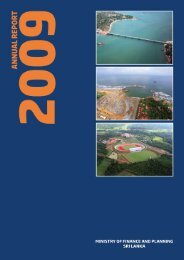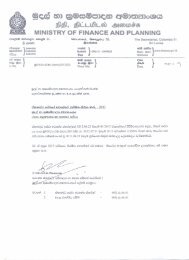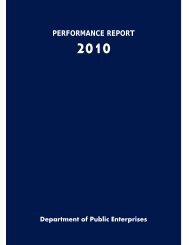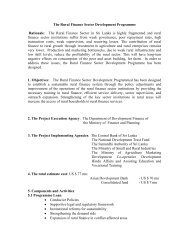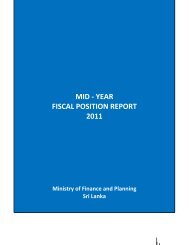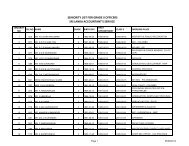Annual Report 2010 - Ministry of Finance and Planning
Annual Report 2010 - Ministry of Finance and Planning
Annual Report 2010 - Ministry of Finance and Planning
You also want an ePaper? Increase the reach of your titles
YUMPU automatically turns print PDFs into web optimized ePapers that Google loves.
1 | DEVELOPMENT PERSPECTIVESEnvironment: A L<strong>and</strong> in Harmonywith NatureThe Mahinda Chintana Policy hasdirected to respect for fauna <strong>and</strong> flora<strong>and</strong> conserving the environment atnational <strong>and</strong> international levels. Inorder to achieve this objective, thegovernment implemented number<strong>of</strong> projects such as ”Pilisaru Project”,”Green Villages”, ”Gririthuru Sevana”<strong>and</strong> ”Gaja Mithuro”. During the period<strong>of</strong> 2006-<strong>2010</strong> government madesignificant total capital investment onenvironment sector.From 2007 onwards, attention hasbeen paid to invest mainly to addressthe issue on solid waste, becauseimproper management <strong>of</strong> solidwaste is one <strong>of</strong> the biggest <strong>and</strong> keyenvironmental problems in Sri Lanka.Investment on environment sectorgradually increased from 2007 to2009 to the implementation <strong>of</strong> ForestResource Management Project incoupled with waste managementprogrammes.Total investment on Pilisaru WasteManagement Project was Rs 695 millionin <strong>2010</strong>, which is around 40 percent <strong>of</strong>the total budgetary allocation. Underthe Pilisaru programme construction<strong>of</strong> compost plants at Kalutara,Panadura, Kuliyapitiya ,Medirigiriya,Anuradhapura, Bulathkohupitiya,Kaduwela, Agalawatta, B<strong>and</strong>ragamalocal authority areas have beencompleted <strong>and</strong> 18,023 compost binshave been distributed among the60 Local Authorities at a cost <strong>of</strong> halfprice <strong>of</strong> a bin. Another 3,213 bins havebeen distributed to the NorthernProvince, schools, religious places <strong>and</strong>other organizations. Several majorprojects in the environment sectorhave been completed <strong>and</strong> ended in<strong>2010</strong>. Upper watershed ManagementProject, Wildlife <strong>and</strong> Protected AreaManagement Project <strong>and</strong> Forest SectorDevelopment Project are importantamong them.Rs. mn35003000250020001500100050002006Human-elephant conflict is anothersocio-economic problem whichaffects on the economic development.Under the Gajamithuro programmegovernment has increased theallocation from Rs. 144 million in 2009to Rs. 300 million in <strong>2010</strong> to mitigatethe human-elephant conflict.The government has identified theimportance <strong>of</strong> addressing the othermajor environmental issues such as loss<strong>of</strong> biodiversity, l<strong>and</strong> degradation, water<strong>and</strong> air pollution <strong>and</strong> climate changesto conserve the environment for thefuture generation.Real Economy – TowardsHigh ProductivityAgricultureThe government has identified theneed for increasing agriculturalproduction as one <strong>of</strong> the keycontributory factors <strong>of</strong> increasingGDP, the productivity, value addition<strong>and</strong> exports while enhancing livingst<strong>and</strong>ards <strong>of</strong> the farmers <strong>and</strong> ensuringfood in the country. The food security<strong>of</strong> the people can be ensuredthrough sustainable increase in foodChart 1.49 > Investment on Environment20072008Source: Department <strong>of</strong> National Budget2009<strong>2010</strong>production, maintenance <strong>of</strong> prices <strong>and</strong>increase in the income levels <strong>of</strong> lowincome families.Accordingly, the agriculture policy<strong>of</strong> the government aims at achievingfood security <strong>of</strong> people, ensuringsustainable income <strong>and</strong> remunerativeprices for agricultural produce, usinghigh yielding seeds <strong>and</strong> plantingmaterials <strong>and</strong> increasing croppingintensity, productivity <strong>and</strong> l<strong>and</strong> use.The seed policy, which includespromotion <strong>of</strong> supply <strong>of</strong> quality seed<strong>and</strong> planting materials, increase <strong>of</strong> seedsecurity by maintaining buffer stocks,implementation <strong>of</strong> certification <strong>and</strong>quarantine regulation for importedseed <strong>and</strong> planting materials <strong>and</strong>adequate provision <strong>of</strong> quality seed<strong>and</strong> planting material to the marketis the key foundation to fulfill thedevelopment objectives <strong>of</strong> the presentagriculture sector.The Agriculture sector, which is mainlydriven by the higher growth in theproduction <strong>of</strong> paddy, tea, <strong>and</strong> minorexport crops grew by 7.0 percent94





